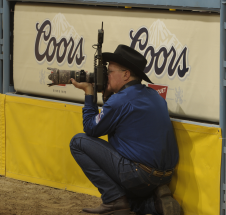 Press Kit
Press Kit
Issuing press credentials to identify working reporters and photographers is a
common practice at all major professional sporting events and your rodeo should
be no different. The practice enables you to keep track of who is doing what,
and to control who has access to restricted areas. The following section
outlines procedures recommended when issuing credentials.
- Maintaining a press credential list
- Compile a list of press members who will want to cover your rodeo.
- Compile a list of press members who request credentials.
- Keep detailed records of credential requests to include:
- Name, address, telephone number, fax number and email address of person making
request.
- Name of media outlet they represent.
- Number of passes requested.
- Dates of the performances requested.
- Type of access requested/needed (i.e. reporter, photographer, TV outlet).
- Preparing and issuing press credentials for the media
- Color code your credentials – for example, red for reporters and blue for
photographers.
* Color-coding badges identifies the type of access the bearer is granted and
enables your staff to quickly identify the bearer and assist with what they
might need.
- Verify all credential requests.
* Media credentials should only be distributed to journalists of recognized news
outlets who are on assignment to cover the event and/or the PRCA. Journalists
must represent recognized daily or weekly newspapers; news services; recognized
publications and outlets that regularly cover rodeo; recognized
national/regional radio and television networks; local radio and television
stations; and/or recognized Internet sites. In each case, this is determined by
the PRCA and the respective rodeo at their sole discretion.
* Freelance journalists and photographers must provide proof of assignment to be
considered for accreditation. They also must sign a form confirming that the
images taken will only be used for that specific publication and for that
specific story. Contact the PRCA Photo Department for the release form.
* Require all media outlets requesting to cover your rodeo to make requests
early enough for you to verify them. If you have questions on any media outlets
and their purpose, please feel free to contact the PRCA Media Department.
* Make sure everyone knows which credentials are being honored and the type of
access the bearer is permitted.
* Work with media representatives who failed to meet your credential request
deadline. Most of these press members are legitimate and have identification
cards from their respective employers. Taking just a few minutes to verify who
they are, then issuing credentials on the spot avoids damaging months of
hard-earned public relations.
- Photographers and arena access
- The PRCA retains all rights in and to the filming, taping, recording in any
media now or hereafter known, still footage/photography, radio or television
broadcasting or reproduction in any manner or form thereof of any
PRCA-sanctioned event. The only exemption is coverage for local, regularly
scheduled newscasts. Any non-local news outlets must first get approval from the
national PRCA office and the local rodeo before it can shoot footage at any
PRCA-sanctioned rodeo.
- Only accredited photographers may shoot at a PRCA-sanctioned rodeo.
* Freelance photographers will not be accredited without proof of assignment for
a specific media outlet and without signing an agreement for limiting usage of
the images to the specified assignment.
* Only PRCA photographers are allowed to shoot in the arena. The only exception
to this is for a post-rodeo ceremony shot, if applicable. PRCA card-holding
photographers should be given arena access whenever possible. They know best how
to put your rodeo in a good light.
* Photographers must shoot from designated photo areas. Photographers may not
shoot behind the bucking chutes during a rough-stock event except with specific
committee approval and may only shoot from there for timed events with the
appropriate approval.
- As a general rule, limit the number of arena-floor photographers to no more than
five.
- Larger rodeos should assign an arena-experienced committee member to assist
legitimate in-arena photographers and keep them from interfering with rodeo
action.
- Because of cumbersome equipment, which equates to a potentially dangerous
situation, television crews should always be accompanied by a committee member
and should not be allowed in the arena.
- PRCA card-holding photographers are the only ones that have the right to sell
their photos. No other photographer should be allowed to sell the photos or use
them for any purpose other than what they were assigned.
- Non-arena photographers
- For safety reasons, inexperienced rodeo photographers should generally be
required to work from behind the arena fence.
- No legitimate news photographer should be required to work from the grandstands
unless there is a specific press area for them to shoot from.
- Media representatives who need special access
- Because of deadlines, or other special circumstances, all media representatives
– photographers, writers, radio and television personnel – might need access to
contestants in the bucking-chute ready area or dressing rooms. Make every effort
to accommodate them.
- For safety reasons and to avoid overcrowding, rotate the media personnel and
always supervise any media activity in those areas.
- Writers who don't require special access
- Seat these reporters in the grandstands in an area with a good view of the
action or above the bucking chutes in the announcers stand if available.
- Provide them with a program, daysheets and rodeo results as soon as they are
available.
- Regardless of the size of your rodeo, it is wise to have a press room. Without
question, larger rodeos should have a press room.
- For additional media guidelines refer to the PRCA Media Guide.